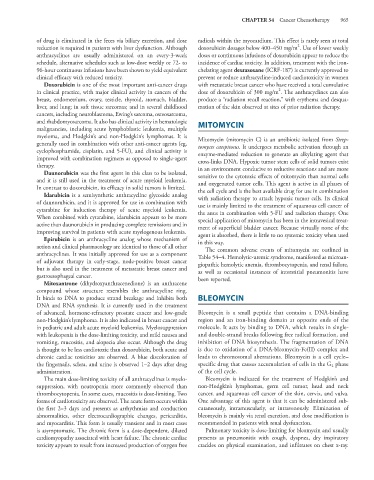Page 979 - Basic _ Clinical Pharmacology ( PDFDrive )
P. 979
CHAPTER 54 Cancer Chemotherapy 965
of drug is eliminated in the feces via biliary excretion, and dose radicals within the myocardium. This effect is rarely seen at total
2
reduction is required in patients with liver dysfunction. Although doxorubicin dosages below 400–450 mg/m . Use of lower weekly
anthracyclines are usually administered on an every-3-week doses or continuous infusions of doxorubicin appear to reduce the
schedule, alternative schedules such as low-dose weekly or 72- to incidence of cardiac toxicity. In addition, treatment with the iron-
96-hour continuous infusions have been shown to yield equivalent chelating agent dexrazoxane (ICRF-187) is currently approved to
clinical efficacy with reduced toxicity. prevent or reduce anthracycline-induced cardiotoxicity in women
Doxorubicin is one of the most important anti-cancer drugs with metastatic breast cancer who have received a total cumulative
2
in clinical practice, with major clinical activity in cancers of the dose of doxorubicin of 300 mg/m . The anthracyclines can also
breast, endometrium, ovary, testicle, thyroid, stomach, bladder, produce a “radiation recall reaction,” with erythema and desqua-
liver, and lung; in soft tissue sarcomas; and in several childhood mation of the skin observed at sites of prior radiation therapy.
cancers, including neuroblastoma, Ewing’s sarcoma, osteosarcoma,
and rhabdomyosarcoma. It also has clinical activity in hematologic MITOMYCIN
malignancies, including acute lymphoblastic leukemia, multiple
myeloma, and Hodgkin’s and non-Hodgkin’s lymphomas. It is Mitomycin (mitomycin C) is an antibiotic isolated from Strep-
generally used in combination with other anti-cancer agents (eg, tomyces caespitosus. It undergoes metabolic activation through an
cyclophosphamide, cisplatin, and 5-FU), and clinical activity is enzyme-mediated reduction to generate an alkylating agent that
improved with combination regimens as opposed to single-agent cross-links DNA. Hypoxic tumor stem cells of solid tumors exist
therapy. in an environment conducive to reductive reactions and are more
Daunorubicin was the first agent in this class to be isolated,
and it is still used in the treatment of acute myeloid leukemia. sensitive to the cytotoxic effects of mitomycin than normal cells
and oxygenated tumor cells. This agent is active in all phases of
In contrast to doxorubicin, its efficacy in solid tumors is limited. the cell cycle and is the best available drug for use in combination
Idarubicin is a semisynthetic anthracycline glycoside analog
of daunorubicin, and it is approved for use in combination with with radiation therapy to attack hypoxic tumor cells. Its clinical
use is mainly limited to the treatment of squamous cell cancer of
cytarabine for induction therapy of acute myeloid leukemia. the anus in combination with 5-FU and radiation therapy. One
When combined with cytarabine, idarubicin appears to be more special application of mitomycin has been in the intravesical treat-
active than daunorubicin in producing complete remissions and in ment of superficial bladder cancer. Because virtually none of the
improving survival in patients with acute myelogenous leukemia. agent is absorbed, there is little to no systemic toxicity when used
Epirubicin is an anthracycline analog whose mechanism of
action and clinical pharmacology are identical to those of all other in this way.
The common adverse events of mitomycin are outlined in
anthracyclines. It was initially approved for use as a component Table 54–4. Hemolytic-uremic syndrome, manifested as microan-
of adjuvant therapy in early-stage, node-positive breast cancer giopathic hemolytic anemia, thrombocytopenia, and renal failure,
but is also used in the treatment of metastatic breast cancer and as well as occasional instances of interstitial pneumonitis have
gastroesophageal cancer. been reported.
Mitoxantrone (dihydroxyanthracenedione) is an anthracene
compound whose structure resembles the anthracycline ring.
It binds to DNA to produce strand breakage and inhibits both BLEOMYCIN
DNA and RNA synthesis. It is currently used in the treatment
of advanced, hormone-refractory prostate cancer and low-grade Bleomycin is a small peptide that contains a DNA-binding
non-Hodgkin’s lymphoma. It is also indicated in breast cancer and region and an iron-binding domain at opposite ends of the
in pediatric and adult acute myeloid leukemias. Myelosuppression molecule. It acts by binding to DNA, which results in single-
with leukopenia is the dose-limiting toxicity, and mild nausea and and double-strand breaks following free radical formation, and
vomiting, mucositis, and alopecia also occur. Although the drug inhibition of DNA biosynthesis. The fragmentation of DNA
is thought to be less cardiotoxic than doxorubicin, both acute and is due to oxidation of a DNA-bleomycin-Fe(II) complex and
chronic cardiac toxicities are observed. A blue discoloration of leads to chromosomal aberrations. Bleomycin is a cell cycle–
the fingernails, sclera, and urine is observed 1–2 days after drug specific drug that causes accumulation of cells in the G phase
2
administration. of the cell cycle.
The main dose-limiting toxicity of all anthracyclines is myelo- Bleomycin is indicated for the treatment of Hodgkin’s and
suppression, with neutropenia more commonly observed than non-Hodgkin’s lymphomas, germ cell tumor, head and neck
thrombocytopenia. In some cases, mucositis is dose-limiting. Two cancer, and squamous cell cancer of the skin, cervix, and vulva.
forms of cardiotoxicity are observed. The acute form occurs within One advantage of this agent is that it can be administered sub-
the first 2–3 days and presents as arrhythmias and conduction cutaneously, intramuscularly, or intravenously. Elimination of
abnormalities, other electrocardiographic changes, pericarditis, bleomycin is mainly via renal excretion, and dose modification is
and myocarditis. This form is usually transient and in most cases recommended in patients with renal dysfunction.
is asymptomatic. The chronic form is a dose-dependent, dilated Pulmonary toxicity is dose-limiting for bleomycin and usually
cardiomyopathy associated with heart failure. The chronic cardiac presents as pneumonitis with cough, dyspnea, dry inspiratory
toxicity appears to result from increased production of oxygen free crackles on physical examination, and infiltrates on chest x-ray.

